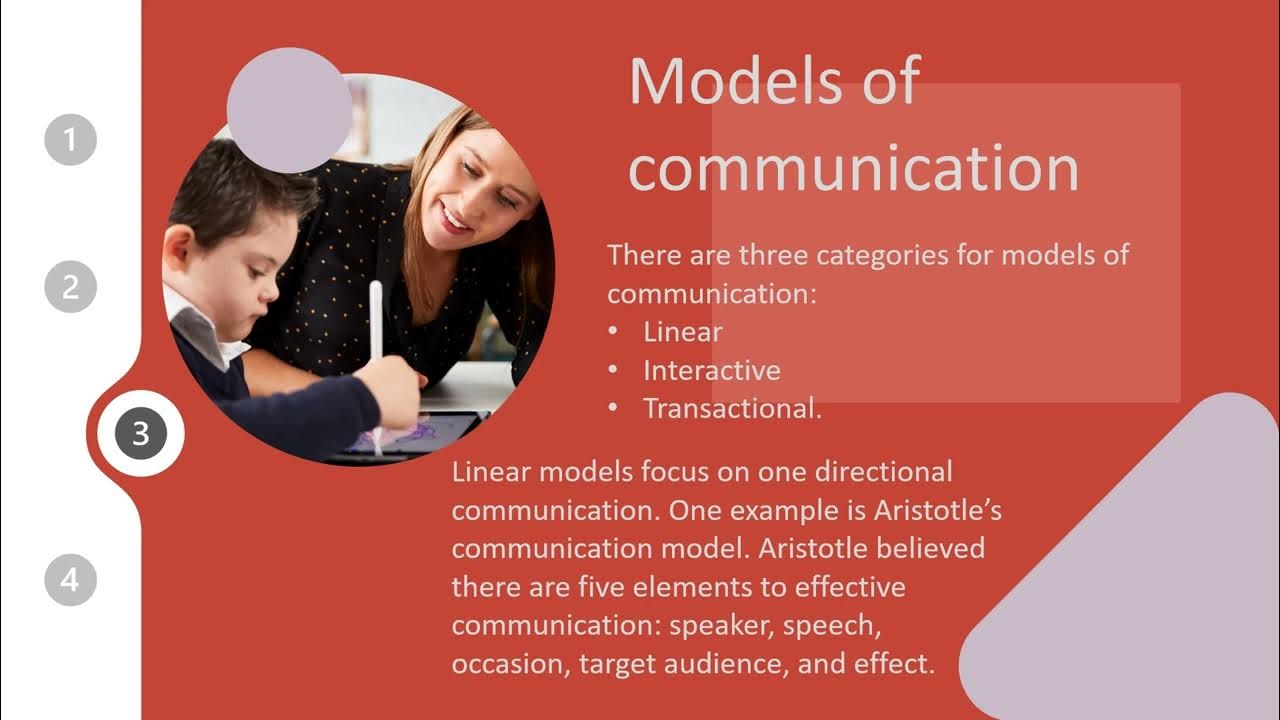INTERACTIVE MODEL
Summary
TLDRThe video explains the interactive communication model, highlighting how it differs from the linear model. While the linear model involves one-way communication, the interactive model is two-way, allowing the receiver to send a response. Noise, which includes distractions or technical issues, can impact both models. In the interactive model, communication can occur through different channels, like sending an email and getting a reply via text. Unlike face-to-face interactions, this model involves a delay in feedback. Examples include emails, letters, and social media platforms, where one party sends a message and waits for a response.
Takeaways
- 📡 The interactive model is a two-way communication process.
- 🗣️ In the linear model, communication is one-way, with the sender sending a message, and the receiver receiving it without response.
- 📩 The interactive model involves both sender and receiver, where the receiver can respond to the message.
- 🔄 In two-way communication, both sender and receiver must encode and decode messages.
- 🔇 Noise can interfere with communication, including physical distractions, lost messages, or mental distractions.
- 📲 Channels in the interactive model do not have to be the same; for example, an email can be replied to with a text message.
- 🤔 The interactive model does not represent face-to-face communication because the response is delayed until the receiver is ready to reply.
- ✉️ Examples of the interactive model include emails, letters, and social media interactions.
- ⏳ In interactive communication, there is a waiting period between sending and receiving a response.
- 📱 Social media platforms like Twitter, Instagram, and Facebook are forms of the interactive model, where users post and wait for responses.
Q & A
What is the key difference between the linear and interactive communication models?
-The key difference is that the linear model involves one-way communication, where the sender sends a message, and the receiver receives it without any interaction. In contrast, the interactive model involves two-way communication, allowing the receiver to respond, and communication can occur over different channels.
What role does noise play in the interactive model?
-Noise in the interactive model refers to any factor that can interfere with communication, such as physical distractions, emotional states, or external disruptions like a lost service. It can affect the sender or receiver's ability to focus on the message.
Can the communication channels differ in the interactive model?
-Yes, in the interactive model, communication channels do not have to be the same. For example, a sender could send an email, and the receiver could respond via text message.
Why doesn't the interactive model represent face-to-face communication?
-The interactive model doesn't represent face-to-face communication because, in face-to-face interactions, there is constant, non-verbal feedback (e.g., facial expressions, body language) while the conversation is happening. In the interactive model, the sender sends a message and waits for a response, without receiving immediate non-verbal feedback.
What is an example of a scenario where the interactive model is used?
-One example of the interactive model is email communication. The sender sends an email, and the receiver reads it and replies later. The interaction happens over time and often through different channels.
How does encoding and decoding work in the interactive model?
-In the interactive model, both the sender and the receiver must encode and decode messages. The sender encodes a message to send, and the receiver decodes it to understand. When the receiver responds, they become the sender, and the process repeats.
What kinds of communication fall under the interactive model?
-Examples of communication that fall under the interactive model include emails, letters, and social media interactions. In these cases, there is a delay between sending and receiving a response, with the possibility of using different channels for communication.
What does the speaker mean by 'noise' in communication?
-In communication, 'noise' refers to anything that disturbs or interferes with the clarity and effectiveness of a message. It can be physical, like not hearing someone speak, or internal, like being distracted or unfocused during communication.
How does the interactive model treat feedback?
-In the interactive model, feedback is delayed. The sender sends a message, waits, and the receiver responds when ready. The feedback loop is not instant, unlike in face-to-face communication.
Why is social media considered part of the interactive model?
-Social media fits into the interactive model because messages are sent out, and responses come later. For instance, someone may post a tweet, and their followers may reply hours or even days later.
Outlines

هذا القسم متوفر فقط للمشتركين. يرجى الترقية للوصول إلى هذه الميزة.
قم بالترقية الآنMindmap

هذا القسم متوفر فقط للمشتركين. يرجى الترقية للوصول إلى هذه الميزة.
قم بالترقية الآنKeywords

هذا القسم متوفر فقط للمشتركين. يرجى الترقية للوصول إلى هذه الميزة.
قم بالترقية الآنHighlights

هذا القسم متوفر فقط للمشتركين. يرجى الترقية للوصول إلى هذه الميزة.
قم بالترقية الآنTranscripts

هذا القسم متوفر فقط للمشتركين. يرجى الترقية للوصول إلى هذه الميزة.
قم بالترقية الآن5.0 / 5 (0 votes)






